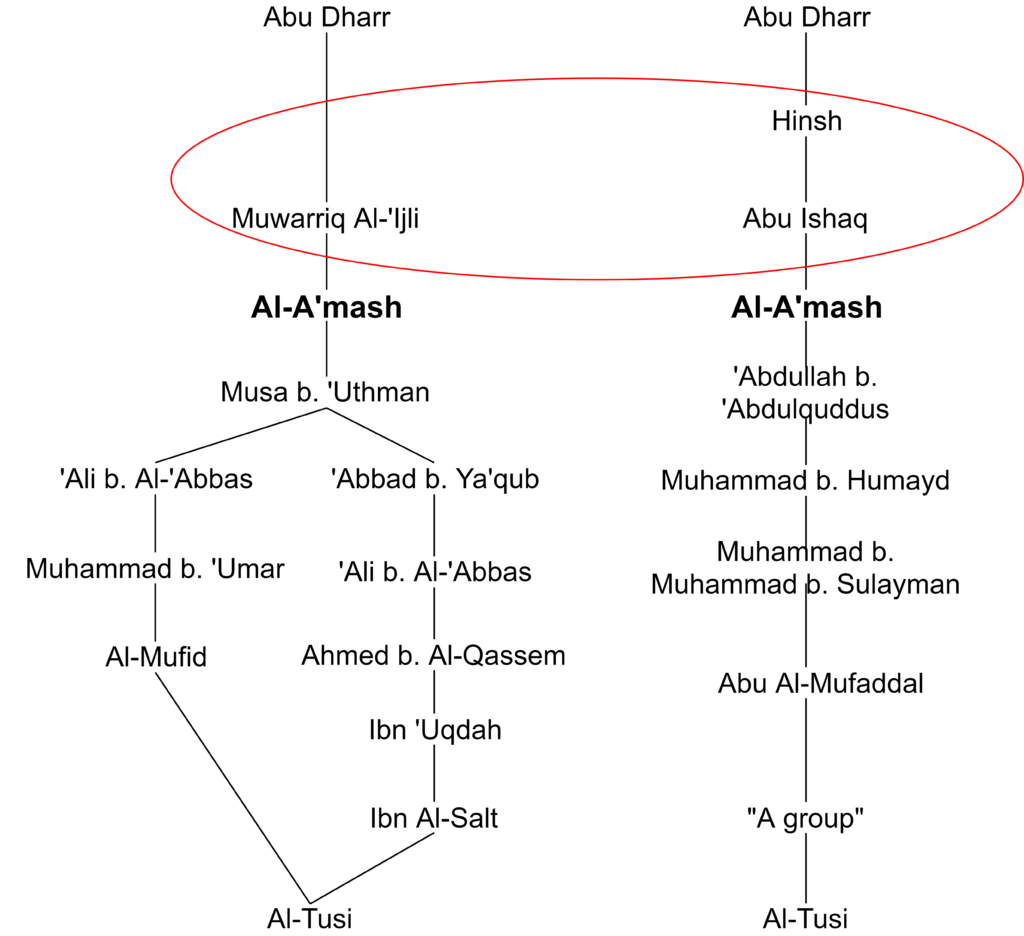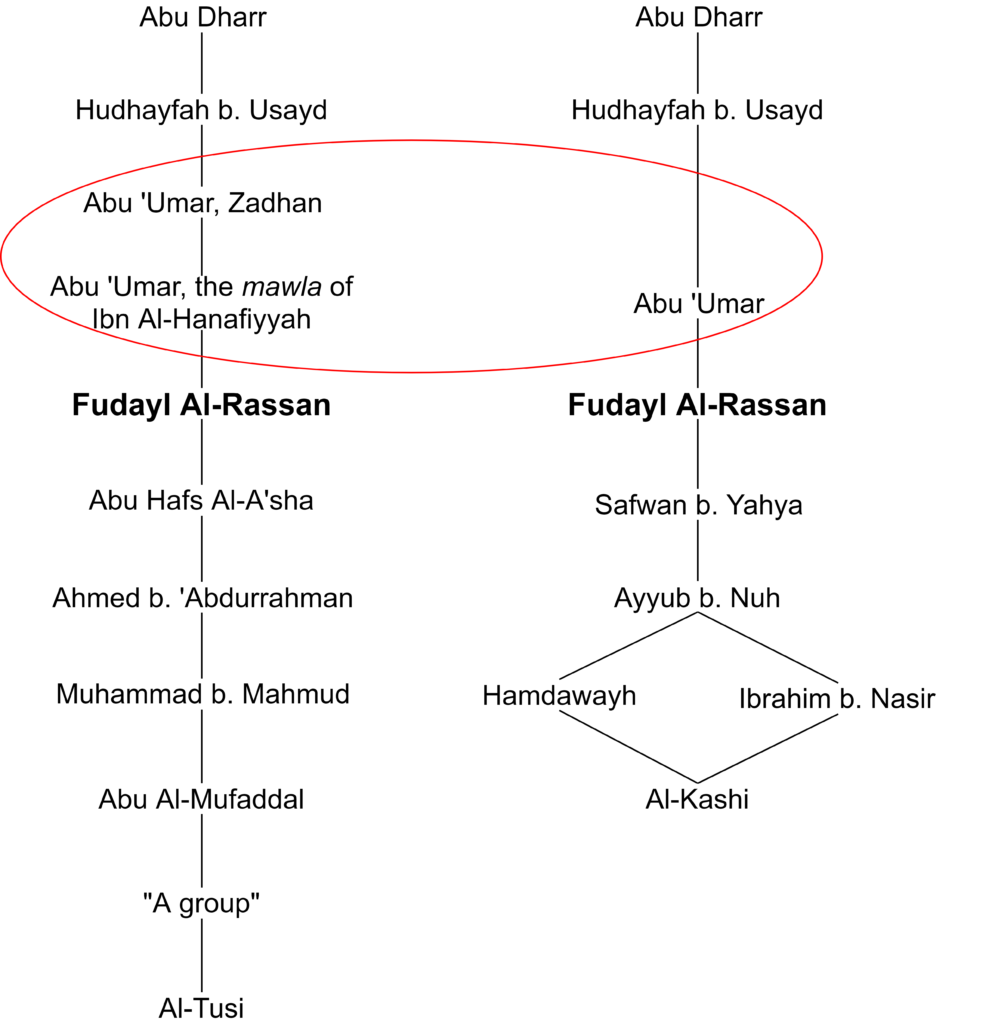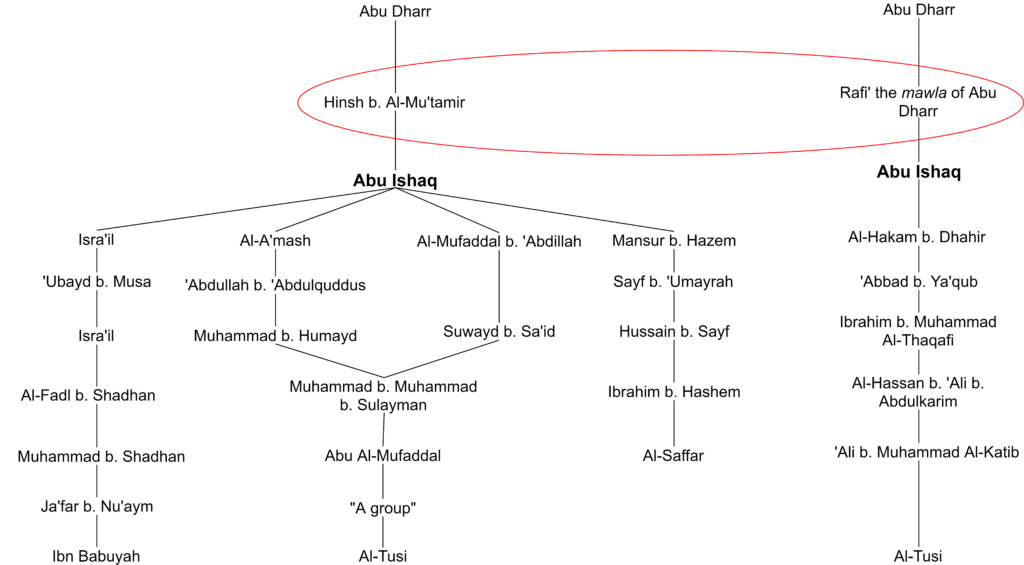A major tradition that is upheld in the Twelver tradition and regularly cited in Suni-Shia polemics is the famous hadith known as “Hadith Al-Safinah” (hadith of the ark). In this report, the Prophet is quoted saying: “My household is like the Ark of Noah: whoever embarks on it is saved, and whoever abandons it is doomed.”
Twelver polemicists usually cite this report from Sunni sources, where it is transmitted with blunderous isnads of no value. This made me interested in evaluating the status of this report in Twelver sources, and I findings confirm what I had initially expected:
- There is not a single authentic isnad for “Hadith Al-Safinah” in Twelver sources (according to Twelver standards.)
- The weakness in most these isnads is severe, usually with more than four unknown/obscure transmitters in each of the isnads.
- Most of the isnads for the hadith converge to a few unreliable transmitters. Thus, the multiple isnads for the hadith are not independent, and they cannot be cited to strengthen each other.
- Many of the isnads conflict with each other, further demonstrating the unreliability of these chains and how they cannot be cited to strengthen each other.
- The report cannot be found in any of the “4 books”, which are the major hadith collections of the Shia. Rather, it is mostly found in auxiliary Twelver hadith collections.
Chains of Transmission for the Hadith:
Note: All of the transmitters in this article were evaluated exclusively according to Twelver standards in Rijal.
Red = Weak Transmitter
Blue = Unknown Transmitter
- Amali Al-Tusi: “A group” → Abu Al-Mufaddal → Muhammad b. Muhammad b. Sulayman → Muhammad b. Humayd → ‘Abdullah b. ‘Abdulquddus → Al-A’mash → Abu Ishaq→ Hinsh b. Al-Mu’tamir → Abu Dharr (Amali Al-Tusi pg. 633)
- Amali Al-Tusi: “A group” → Abu Al-Mufaddal → Muhammad b. Muhammad b. Sulayman → Suwayd b. Sa’id Al-Hadathani → Al-Mufaddal b. ‘Abdillah → Abu Ishaq Al-Hamadani→ Hinsh b. Al-Mu’tamir → Abu Dharr (Amali Al-Tusi pg. 513)
- Amali Al-Tusi: “A group” → Abu Al-Mufaddal → Muhammad b. Mahmud Al-Kindi → Ahmed b. ‘Abdurrahman → Abu Hafs Al-A’sha → Fudayl Al-Rassan* → Abu ‘Umar the mawla of Ibn Al-Hanafiyyah → Abu ‘Umar Zadhan → Hudhayfah b. Usayd → Abu Dharr (Amali Al-Tusi pg. 459)
- Amali Al-Tusi: “A group” → Abu Al-Mufaddal → Muhammad b. Jarir Al-Tabari → ‘Isa b. Mihran → Mikhwal b. Ibrahim → ‘Abdurrahman b. Al-Aswad → ‘Ali b. Al-Hzawwar → Abu ‘Umar Al-Bazzaz→ Rafi’ the Mawla of Abu Dharr → Abu Dharr (Amali Al-Tusi pg. 733)
- Kanz Al-Fawa’id: Ahmed b. Hamza Al-Husayni, Abu Al-Abbas Ahmed b. Isma’il, & Abu Al-Raja Muhammad b. ‘Ali → Abu Al-Mufaddal → Ahmed b. ‘Abdillah Al-Thaqafi → ‘Muhammad b. ‘Ali b. Khalaf → Musa b. Ja’far Al-Himyari → ‘Abdullah b. Al-Muhaymin → His father→ Sahl b. Sa’d→ Abu Dharr (Bihar Al-Anwar 27/112)
- Makarim Al-Akhlaq: Abu Ja’far Al-Tusi → “A group” → Abu Al-Mufaddal → Rajaa’ b. Yahya → Muhammad b. Al-Hussain b. Maymun →’Abdullah b. ‘Abdurrahman Al-Asamm →Al-Fudayl b. Yasar →Wahb b. ‘Abdillah Al-Hanna’i→ Abu Harb b. Abi Al-Asawd Al-Du’ali→ Abu Al-Aswad Al-Du’ali → Abu Dاarr (Makarim Al-Akhlaq pg. 458)
- Amali Al-Mufid: ‘Ali b. Bilal Al-Muhallabi → ‘Ali b. ‘Abdillah Al-Asfahani → Ibrahim b. Muhammad Al-Thaqafi → Isma’il b. Aban → Al-Sabbah b. Yahya → Al-A’mash → Al-Minhal b. ‘Amr → ‘Abbad b. ‘Abdillah → ‘Ali b. Abi Taleb (Amali Al-Mufid 145)
- Amali Al-Tusi: Al-Mufid → Muhammad b. ‘Umar → ‘Ali b. Al-Abbas b. Al-Walid → Musa b. ‘Uthman Al-Hadhrami → Al-A’mash → Muwarriq Al-‘Ijli → Abu Dharr (Amali Al-Tusi pg. 733)
- Amali Al-Tusi: Ibn Al-Salt → Ibn ‘Uqdah → Ahmed b. Al-Qasem Al-Akfani → ‘Abbad b. Ya’qub → Musa b. ‘Uthman Al-Hadhrami → Al-A’mash → Muwarriq Al-‘Ijli → Abu Dharr (Bihar Al-Anwar 23/123)
- Amali Al-Tusi: Al-Mufid → ‘Ali b. Muhammad Al-Katib → Al-Hassan b. ‘Ali b. ‘Abdulkarim → Ibrahim b. Muhammad Al-Thaqafi → ‘Abbad b. Ya’qub → Al-Hakam b. Dhahir → Abu Ishaq → Rafi’ the mawla of Abu Dharr → Abu Dharr (Amali Al-Tusi pg. 60)
- Muhammad Al-Tabari, in Bisharat Al-Mustafa, transmitted it with the previous isnad ras well. (Bisharat Al-Mustafa pg. 145)
- Amali Al-Tusi: Hilal b. Muhammad Al-Haffar → Muhammad b. Hamza b. Muhammad → ‘Ali b. Muhammad Al-Bazzaz → Ibrahim b. Ishaq b. Abi Al-‘Anbas → Muhammad b. Al-Hassan Al-Saluli →Salih b. Abi Al-Aswad → Aban b. Taghlib → Hinsh b. Al-Mu’tamir→ Abu Dharr
(Amali Al-Tusi pg. 349) - Ikhtiyar Ma’rifat Al-Rijal: Hamdawayh & Ibrahim b. Nasir → Ayyub b. Nuh → Safwan b. Yahya → Fudayl Al-Rassan* → Abu ‘Umar → Hudhayfah b. Usayd → Abu Dharr (Ikhtiyar Ma’rifat Al-Rijal 1/115)
- Amali Al-Saduq & Kamal Al-Din wa Tama Al-Ni’mah: Ali b. Ahmed b. ‘Abdillah → his father → his grandfather (Ahmed b. Abi ‘Abdillah Al-Barqi) → His father, Muhammad b. Khaled (conhitested status) → Ghiyath b. Ibrahim → Thabit b. Dinar → Sa’d b. Tarif → Sa’id b. Jubayr → Ibn ‘Abbas (Kamal Al-Din 1/269) (Amali Al-Saduq 342)
- Al-Khisal: Ahmed b. Al-Hasan Al-Qattan, Muhammad b. Ahmed Al-Sinani, ‘Ali Al-Daqqaq, Al-Hussain b. Ibrahim Al-Muktib, ‘Ali b. ‘Abdillah Al-Warraq → Ahmed b. Yahya Al-Qattan → Bakr b. ‘Abdillah→ Tamim b. Bahlul → Sulayman b. Hakim → Thawr b. Yazid → Makhul → ‘Ali (Al-Khisal pg.573)
- Kifayat Al-Athar: ‘Ali b. Al-Hassan b. Muhammad b. Mandah → Harun b. Musa → Ibn ‘Uqdah → Muhammad b. Ghiyath→ Hammad b. Abi Hazem → ‘Imran b. Muhammad → Muhammad b. Sa’id → Sa’id b. Al-Musayyab → Abu Sa’id (Kifayat Al-Athar 34)
- Kifayat Al-Athar: ‘Ali b. Al-Hassan b. Muhammad b. Mandah → Harun b. Musa → Ibn ‘Uqdah → Muhammad b. Salem b. ‘Abdurrahman → Al-Hassan b. Abi Ja’far → ‘Ali b. Zaid b. Jud’an → Sa’id b. Al-Musayyab → Abu Dharr (Kifayat Al-Athar 38)
- Basa’ir Al-Darajat: Ibrahim b. Hashem → Al-Hussain b. Sayf → His father → Mansur b. Hazem → Abu Ishaq Al-Hamadani → Abu Al-Mu’tamir (Hinsh) → Abu Dharr (Basa’ir Al-Darajat pg. 317)
- Khasa’is Al-A’immah: Harun b. Musa → Muhammad b. Ahmed b. ‘Ubaydillah b. Ahmed → ‘Isa b. Ahmed b. ‘Isa → Al-Hasan Al-‘Askari → ‘Ali b. Muhammad → Muhammad b. ‘Ali → ‘Ali b. Musa → Musa b. Ja’far → Ja’far b. Muhammad → His fathers…. → ‘Ali (Khasa’is Al-A’immah pg. 77)
- Kamal Al-Din Wa Tamam Al-Ni’mah: Ja’far b. Nu’aym → Muhammad b. Shadhan → Al-Fadl b. Shadhan → ‘Ubayd b. Musa → Isra’ill → Abu Ishaq → Hinsh b. Al-Mu’tamir → Abu Dharr (Kamal Al-Din 239)
- ‘Uyun Akhbar Al-Ridha: Multiple isnads
Muhammad b. ‘Ali b. Al-Shah → Muhammad b. ‘Abdillah Al-Naysauburi → ‘Abdullah b. Ahmed b. ‘Amer→ ‘Ahmed Amer b. Sulayman → ‘Ali b. Musa Al-Ridha.
Ahmed b. Ibrahim b. Bakr → Ibrahim b. Harun b. Muhammad → Ja’far b. Muhammad b. Ziyad → Ahmed b. ‘Abdillah Al-Harawi → ‘Ali b. Musa Al-Rida
Al-Hussain b. Muhammad Al-Ashnani → ‘Ali b. Muhammad b. Mahrawayh
→ Dawud b. Sulayman Al-Farra’ → ‘Ali b. Musa Al-Rida (Uyun Akhbar Al-Rida 1/30)
*Al-Khoei concluded that Fudayl Al-Rassan was reliable due to his inclusion in Tafsir Al-Qommi. Various Twelver authorities today, however, have rightfully asserted that the preface to Tafsir Al-Qommi is inauthentic. Thus the inclusion of Fudayl Al-Rassan in Tafsir Al-Qommi is not tantamount to an endorsement , and he is unknown.
Can these Isnads Strengthen Each Other?
As seen above, every single isnad for this report is extremely weak and contains (at least) two unknown transmitters. Twelver polemicists, however, may attempt to argue that the abundance of isnads for this hadith can strengthen the hadith and elevate it to the status of authenticity.
Such appeals are futile. This claim assumes that all of these isnads are independent such that they are able to strengthen each other. A careful analysis of these isnads, however, demonstrates that most of the chains of transmission are not independent of each other.
- Reports 1-6 are all transmitted by Abu Al-Mufaddal Al-Shaybani, who was very weak.
- Reports 1, 2 , 11, 17 and 19 are all transmitted by the unknown transmitter, Hinsh b. Al-Mu’tamir.
- Reports 1, 2, 9, 11, 17 and 19 are all transmitted by the unknown transmitter Abu Ishaq Al-Hamadani.
- Reports 3, 4 and 12 are all transmitted by the anonymous transmitter, Abu ‘Umar.
- Reports 7 and 8 are both transmitted by the unknown transmitter, Musa b. ‘Uthman Al-Hadhrami.
- Reports 16 and 17 are both transmitted by the unknown transmitter, Sa’id b. Al-Musayyab.
It must be similarly noted that the extreme weakness in each of these isnads opens the possibility that they may all actually stem from one source, even though they may apparently not seem to. One cannot dispel the possibility that the tens of anonymous and unknown transmitters who all transmitted this report may have colluded with each other, or erroneously ascribed the report to multiple isnads.
Conflicting Isnads
Asides from the severe weakness of each of the isnads and their transmission through interdependent sources, another problem remains: the various contradictions in these chains of transmission. These interdependent isnads contradict each other on a variety of occasions, further demonstrating their unreliability.
Figure 1. Conflicting trasnmission from Al-A’mash
Figure 2. Conflicting transmission from Fudayl Al-Rassan
Note: Fudayl Al-Rassan was unknown, so there also is a possibility that the discrepancies in transmission are from Fudayl himself.
Figure 3. Conflicting transmission from Abu Ishaq
Note: Abu Ishaq is an unknown transmitter,and there is a possibility that the discrepancies in transmission stem from him.
Various other defects exist in the isnads for this report, but these examples shall suffice to demonstrate the defective transmission of this alleged hadith and the interdependence of isnads that may, at first glance, seem independent.
Conclusion
As demonstrated above, “Hadith Al-Safinah” clearly is an inauthentic tradition in Twelver sources. The weakness of this report manifests in several phenomena, such as:
- The overwhelming unreliability of its transmitters.
- The interdependence of these unreliably transmitted isnads.
- The conflicting transmission from these interdependent isnads.
These observations cumulatively demonstrate the baselessness of this fabricated hadith, which was falsely ascribed to the Prophet . Ironically, Twelver polemicists today have the audacity to argue for the authenticity report from Sunni sources not knowing that it is baseless in their very own tradition. If the report is this weak in the Twelver tradition, then it should not be a surprise to Shi’ites today that it is even weaker in the Sunni tradition.
After reading this article, every Twelver must ask himself:
“Why is it that such an apparently fundamental report was exclusively transmitted by weak and unknown transmitters?”
“Why did the reliable transmitters of the time refrain from transmitting this report such that we do not possess a single authentic connected isnad for this hadith?”
Perhaps these questions (and others) may lead the sincere reader to the truth regarding this baseless Shi’ite fabrication.
And Allah is the witness of Abu Al-Abbas





Fascinating!!. However, i think that when we Sunnis say ‘the report is weak’, i think what goes through the mind of a shia generally is ‘they just call it weak because they dont like Ahlul Bayt and want to demote their status, so their evil muhadithun called it weak but it is in fact very strong’. I am fully aware that the reality of the matter is the opposite, but i am 90% sure that that is how a Shia feels/thinks. If you really want to convince a Shia to NOT use weak reports, i think it would be a really effective technique to write an article where you use weak reports to make up an aqeedah for an imaginary sect, whose beliefs are in direct contradiction to the twelver theology. You can call this imaginary sect whatever, and make up a belief that directly conflicts with their(twelver shia) belief. For example, you can make up an imaginary sect called Umariya or something who believe that it is ONLY the descendants of Umer(RA) that should rule over the muslim world. You can call that article ‘a theoretical exercise in making up different aqeedah using selective weak reports’ or something along those lines. The goal would be to show that if they want to rely on weak reports to PROVE their aqeedah, than some other sect can use weak reports to PROVE their OWN aqeedah that DIRECTLY CONFLICTS with their aqeedah. There is no such thing as a free meal in this world. Lastly, I really liked the diagrams for the chains as well. Made the information easier to digest. Keep up the good work!
This is a very interesting idea. Will check it out iA.